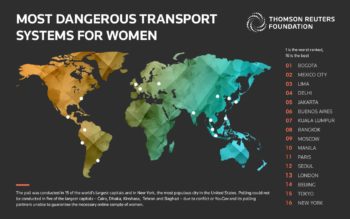News – Blog
How could cities help end harassment on public transport?
17 August 2023
- Catherine Thompson
How do you move about your city? What stops you moving smoothly? We explore a key barrier to mobility in cities across the globe – a barrier we’d be keen to support cities to address in the Sustainable Cities Challenge.
55% of women and 21% of men have experienced sexual harassment or assault on public transport in London. Accurate and up-to-date data in cities across the world can be difficult to come by, especially given the low reporting rates, but a report by the Thomson Reuters Foundation back in 2014 actually ranked London as having one of the safest transport for women against a backdrop of other international cities, with Bogotá, Mexico City and Lima ranking the lowest in those polled. In Mexico City, 151 of 200 women polled said safety was their top transport concern.
It’s also well documented that many sexual assaults happen in front of bystanders; a study by BIT and BRAC in Dhaka, Bangladesh found that bystanders intervene just 1 in 5 times.
There’s an argument that you can’t address sexual harassment and assault on public transport without looking more widely at the issue across the public realm, but research by Right to Be found that mobility plays a critical role in advantaging the perpetrator.[4] The fear of sexual harassment or assault on public transport can weigh heavily on people, and it acts as a major barrier to mobility for many.
Minoritized groups are also affected by harassment and abuse while getting from one place to another. According to Stonewall, Lesbian, Gay, Bisexual and Trans (LGBT) people are statistically more vulnerable to verbal and physical abuse generally and one in five LGBT people in Britain (21%) have experienced a hate crime or incident due to their sexual orientation and/or gender identity in the last 12 months.
“Is it best for me to travel at busy commuting times, or is it best to travel when trains are slightly less crowded; times when I can have more space? Can I stay late in the office, or go to do some chores in town or will the later service be too quiet? Shall I sit upstairs on the bus, or am I safer near the driver? Can I afford a taxi instead? What about the taxi driver? How am I going to get safely to and from the transit station early when it’s still dark out? Will I be attacked based on the way I look? Or my identity? Should I accept this job, will I be able to get there safely? Is this the right school for my child? Will they be safe travelling there alone as a teenager?” People shouldn’t have to ask these questions or wonder if they are going to be safe.
In the Right to Be research, they used the definition of physical mobility as “the ability to move from one place to another smoothly, quickly and without impediment”. It’s clear from this definition, that sexual assault and harassment can act as a barrier to mobility for many.
Overcoming Mobility Barriers
We believe it is critical for people everywhere to be able to move about their cities as they need to, when they need to. That is one reason that we are partnering with the Toyota Mobility Foundation to run the Sustainable Cities Challenge. We are currently calling for cities who are interested in hosting a City Challenge to solve problems like this in their community.
The fear of sexual harassment or assault we explore here is just one potential barrier to mobility; many city residents and visitors face barriers in accessing transport, public services, and amenities in their everyday lives. This can prevent people from accessing the many opportunities offered within cities, from jobs to education and the ability to connect with others.
In the Sustainable Cities Challenge, we want to hear from cities that recognize how opening up mobility systems to everyone is key to creating a more inclusive society. We’re seeking cities that want to find new solutions to overcome mobility barriers – for example, exploring ways to make transportation more accessible for people who have disabilities, developing innovative payment approaches to improve the affordability of transport, exploring how cities can work better for children and their carers.
If you work for a city and you’re interested in finding out more about the Challenge, and how you can unlock up to $3 million in innovation funding, find out more about the Challenge at sustainablecitieschallenge.org.





